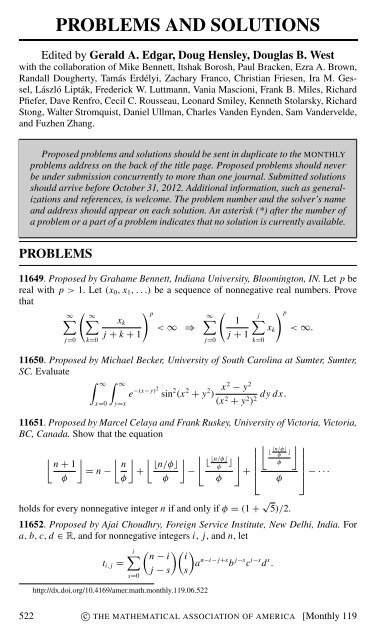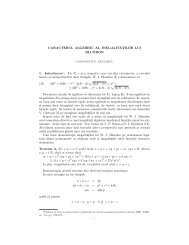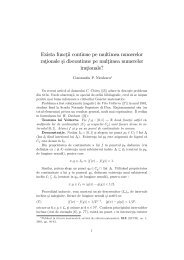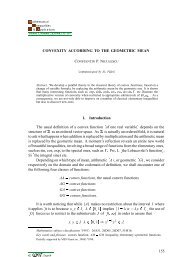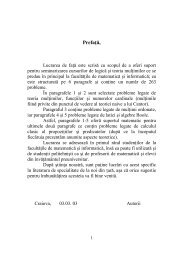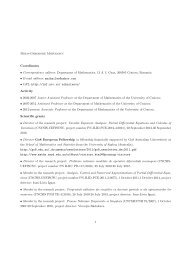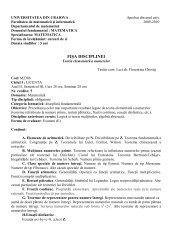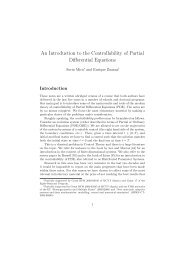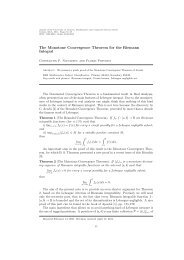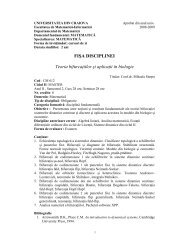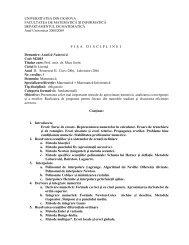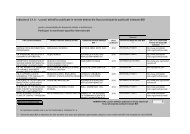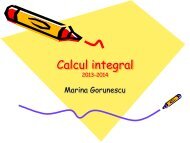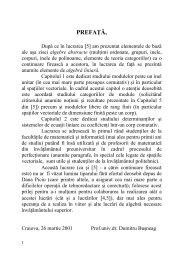PROBLEMS AND SOLUTIONS
PROBLEMS AND SOLUTIONS
PROBLEMS AND SOLUTIONS
You also want an ePaper? Increase the reach of your titles
YUMPU automatically turns print PDFs into web optimized ePapers that Google loves.
<strong>PROBLEMS</strong> <strong>AND</strong> <strong>SOLUTIONS</strong>Edited by Gerald A. Edgar, Doug Hensley, Douglas B. Westwith the collaboration of Mike Bennett, Itshak Borosh, Paul Bracken, Ezra A. Brown,Randall Dougherty, Tamás Erdélyi, Zachary Franco, Christian Friesen, Ira M. Gessel,László Lipták, Frederick W. Luttmann, Vania Mascioni, Frank B. Miles, RichardPfiefer, Dave Renfro, Cecil C. Rousseau, Leonard Smiley, Kenneth Stolarsky, RichardStong, Walter Stromquist, Daniel Ullman, Charles Vanden Eynden, Sam Vandervelde,and Fuzhen Zhang.Proposed problems and solutions should be sent in duplicate to the MONTHLYproblems address on the back of the title page. Proposed problems should neverbe under submission concurrently to more than one journal. Submitted solutionsshould arrive before October 31, 2012. Additional information, such as generalizationsand references, is welcome. The problem number and the solver’s nameand address should appear on each solution. An asterisk (*) after the number ofa problem or a part of a problem indicates that no solution is currently available.<strong>PROBLEMS</strong>11649. Proposed by Grahame Bennett, Indiana University, Bloomington, IN. Let p bereal with p > 1. Let (x 0 , x 1 , . . .) be a sequence of nonnegative real numbers. Provethat(∞∑ ∑ ∞j=0k=0x kj + k + 1) p< ∞ ⇒(∞∑j=01j + 1) pj∑x k < ∞.11650. Proposed by Michael Becker, University of South Carolina at Sumter, Sumter,SC. Evaluate∫ ∞ ∫ ∞x=0y=xe −(x−y)2 sin 2 (x 2 + y 2 ) x 2 − y 2k=0dy dx.(x 2 + y 2 )211651. Proposed by Marcel Celaya and Frank Ruskey, University of Victoria, Victoria,BC, Canada. Show that the equation⌊ ⌋⌊ ⌋ ⌊ ⌋ ⌊ ⌋ ⌊ ⌋⌊n + 1 n ⌊n/φ⌋ ⌊⌊n/φ⌋⌊n/φ⌋φ ⌋⌋φφ= n − + − + ⎢ ⎥φφ φ φ ⎣ φ ⎦ − · · ·holds for every nonnegative integer n if and only if φ = (1 + √ 5)/2.11652. Proposed by Ajai Choudhry, Foreign Service Institute, New Delhi, India. Fora, b, c, d ∈ R, and for nonnegative integers i, j, and n, leti∑( ) n − i it i, j =aj − s)( n−i− j+s b j−s c i−s d s .ss=0http://dx.doi.org/10.4169/amer.math.monthly.119.06.522522 c○ THE MATHEMATICAL ASSOCIATION OF AMERICA [Monthly 119
Let T (a, b, c, d, n) be the (n + 1)-by-(n + 1) matrix with (i, j)-entry given by t i, j , fori, j ∈ {0, . . . , n}. Show that det T (a, b, c, d, n) = (ad − bc) n(n+1)/2 .11653. Proposed by Finbarr Holland, University College Cork, Cork, Ireland. Let nbe a positive integer. Determine all entire functions f that satisfy, for all complex sand t, the functional equationf (s + t) =∑n−1k=0Here, f (m) denotes the mth derivative of f .f (n−1−k) (s) f (k) (t).11654. Proposed by David Borwein, University of Western Ontario, Canada, andJonathan M. Borwein and James Wan, CARMA, University of Newcastle, Australia.Let Cl denote the Clausen function, given by Cl(θ) = ∑ ∞n=1 sin(nθ)/n2 . Let ζ denotethe Riemann zeta function.(a) Show that∫ 2π ∫ 2πy=0(b) Show that∫ πy=0x=0∫ πx=0log(3 + 2 cos x + 2 cos y + 2 cos(x − y)) dx dy = 8πCl(π/3).log(3 + 2 cos x + 2 cos y + 2 cos(x − y)) dx dy = 283 ζ(3).11655. Proposed by Pál Péter Dályay, Szeged, Hungary. Let ABCD be a convexquadrilateral, and let α, β, γ , and δ be the radian measures of angles DAB, ABC, BCD,and CDA, respectively. Suppose α + β > π and α + δ > π, and let η = α + β − πand φ = α + δ − π. Let a, b, c, d, e, f be real numbers with ac = bd = ef . Showthat if abe > 0, thena cos α + b cos β + c cos γ + d cos δ + e cos η + f cos φ ≤ be2a + cf2b + de2c + a f2d ,while for abe < 0 the inequality is reversed.<strong>SOLUTIONS</strong>A Triangle Inequality11527 [2010, 742]. Proposed by Cezar Lupu, student, University of Bucharest,Bucharest, Romania. Prove that in an acute triangle with sides of length a, b, c,inradius r, and circumradius R,a 2b 2 + c 2 − a 2 + b 2c 2 + a 2 − b 2 + c 2a 2 + b 2 − c 2 ≥ 3 2 · Rr .Solution by Thomas Smotzer, Youngstown State University, Youngstown, OH. Let△ABC be acute, with side lengths a, b, c, area K , and semiperimeter p. Let S =S(a, b, c) be the sum on the left in the required inequality. Note that K = 1 bc sin A,2June–July 2012] <strong>PROBLEMS</strong> <strong>AND</strong> <strong>SOLUTIONS</strong> 523
B ′ C ′ MCA ′2R b2R aA2R cBHowever, |MA ′ | is the diameter of the circumcircle for △BAC, that is, |MA ′ | = 2R a .Therefore, using this in (1) givesSimilarly,2R a ≥ |C ′ A ′ ||B ′ C ′ | |MC| + |A′ B ′ ||MB|. (2)|B ′ C ′ |2R b ≥ |A′ B ′ ||C ′ A ′ | |MA| + |B′ C ′ ||MC|, (3)|C ′ A ′ |2R c ≥ |B′ C ′ ||A ′ B ′ | |MB| + |C ′ A ′ ||MA|. (4)|A ′ B ′ |Multiplying (2) by λ 2 1 , (3) by λ2 2 , and (4) by λ2 3, then adding, we obtain( λ2λ 2 1 R a + 2λ 2 2 R b + 2λ 2 23 R c ≥ 2|A ′ B ′ |+ λ2 3 |C )′ A ′ ||MA||C ′ A ′ | |A ′ B ′ |( ) ( )λ2+ 1|A ′ B ′ |+ λ2 3 |B′ C ′ | λ2|MB| + 1|C ′ A ′ |+ λ2 2 |B′ C ′ ||MC|. (5)|B ′ C ′ | |A ′ B ′ ||B ′ C ′ | |C ′ A ′ |For any real x and y, x 2 + y 2 ≥ 2xy. Applying this to the coefficient of |MA| on theright of (5), we getλ 2 2 |A′ B ′ | 2 + λ 2 3 |C ′ A ′ | 2|A ′ B ′ ||C ′ A ′ |≥ 2λ 2 λ 3 .Similar inequalities follow for the other two terms in (5), and so (5) implies2λ 2 1 R a + 2λ 2 2 R b + 2λ 2 3 R c ≥ 2λ 2 λ 3 |MA| + 2λ 1 λ 3 |MB| + 2λ 1 λ 2 |MC|.This is the required inequality, namelyλ 2 1 R a + λ 2 2 R b + λ 2 3 R c ≥ λ 1 λ 2 λ 3( |MA|λ 1+ |MB|λ 2+ |MC|λ 3).Equality holds when △ABC is equilateral, M is the circumcenter, and λ 1 = λ 2 = λ 3 .Also solved by M. Bataille (France), P. P. Dályay (Hungary), O. Faynshteyn (Germany), O. Geupel (Germany),O. Kouba (Syria), J. H. Smith, T. Smotzer, R. Stong, M. Tetiva (Romania), Z. Vörös (Hungary), J. B. Zacharias& K. T. Greeson, and the proposer.June–July 2012] <strong>PROBLEMS</strong> <strong>AND</strong> <strong>SOLUTIONS</strong> 525
Zero–Nonzero Matrices11534 [2010, 835]. Proposed by Christopher Hillar, Mathematical Sciences ResearchInstitute, Berkeley, CA. Let k and n be positive integers with k < n. Characterize then × n real matrices M with the property that for all v ∈ R n with at most k nonzeroentries, Mv also has at most k nonzero entries.Solution by Richard Stong, Center for Communications Research, San Diego, CA. Weshow that either M has at most k nonzero rows or M has at most 1 nonzero entry inevery column. Such a matrix has the desired property: in the first case Mv has at mostk nonzero entries for any v, and in the second case Mv has at most as many nonzeroentries as v.Now suppose that some matrix M with the desired property is not of the formstated. Thus M has at least k + 1 rows with nonzero entries and at least one columnwith at least two nonzero entries. Build a list of columns of M as follows: say a listof columns represents a row if and only if at least one of the columns in the set hasa nonzero entry in that row. Start with a column w 1 with at least two nonzero entries.If w 1 , . . . , w r have been chosen, and together they represent fewer than k + 1 rows,then choose w r+1 to be any column that represents a new row and append it to the list.Stop when w 1 , . . . , w r represent at least k + 1 rows. Now we started with a columnrepresenting two rows, and each time we added a new column we got at least one newrow. Hence r ≤ k. Thus any linear combination ∑ rj=1 a jw j is of the form Mv, wherev has at most k nonzero entries. Fix k + 1 rows represented by the w j . For the ith suchrow, let V i be the set of all r-tuples (a 1 , . . . , a r ) such that ∑ rj=1 a jw j has a nonzeroentry in that ith row. Since w 1 , . . . , w r do represent this row, V i is the nullspace of anontrivial linear equation on r-tuples and therefore is a codimension-1 subspace of R r .However, the required property of M says that for any r-tuple (a 1 , . . . , a r ), the linearcombination ∑ rj=1 a jv j has at most k nonzero entries; thus (a 1 , . . . , a r ) must lie inone of these k + 1 subspaces. But of course R r cannot be covered by finitely manycodimension-1 subspaces. This contradiction shows that such an M cannot exist.Editorial comment. Several solvers noted that the same result holds for any field ofcharacteristic 0. John Smith (Needham, MA) noted that the result holds for rectangularmatrices.Also solved by P. Budney, N. Caro (Brazil), P. P. Dályay (Hungary), E. A. Herman, Y. J. Ionin, J. H. Lindsey II,O. P. Lossers (Netherlands), R. E. Prather, J. Simons (U. K.), J. H. Smith, M. Tetiva (Romania), E. I. Verriest,Barclays Capital Problems Solving Group (U. K.), NSA Problems Group, and the proposer.How Closely Does This Sum Approximate the Integral?11535 [2010, 835]. Proposed by Marian Tetiva, Bîrlad, Romania. Let f be a continuouslydifferentiable function on [0, 1]. Let A = f (1) and let B = ∫ 1x −1/2 f (x) dx.0Evaluate( ∫ 1n∑( ) ( ) )k2lim n (k − 1)2 (k − 1)2f (x) dx − − fn→∞0n2 n 2 n 2in terms of A and B.k=1Solution by Eugene A. Herman, Grinnell College, Grinnell, IA. Answer: A − B/2.Proposition. If h is continuously differentiable on [0, 1], then( ∫ 1lim n h(x) dx − 1 n∑( ) ) k − 1 h(1) − h(0)h = .n→∞0n n2k=1526 c○ THE MATHEMATICAL ASSOCIATION OF AMERICA [Monthly 119
Proof. Let H denote an antiderivative of h. By Taylor’s theorem,∫ 1h(y) dy − 1 n∑( ) k − 1n∑(∫ k/nh =h(y) dy − 1 ( )) k − 1n nn h n0=n∑k=1(Hk=1( kn)− H( k − 1nk=1(k−1)/n)− 1 ( )) k − 1n H ′ n= 12n 2n∑H ′′ (y k ),for some list (y 1 , . . . , y n ) with y k ∈ ((k − 1)/n, k/n) for 1 ≤ k ≤ n. Therefore,( ∫ 1n∑( ) )k − 1 1lim n h(y) dy − h= 1n→∞0n n 2 lim 1n∑H ′′ (y k )n→∞ n= 1 2∫ 10k=1h ′ (y) dy =h(1) − h(0).2For this problem, let h(y) = 2y f (y 2 ). Now (h(1) − h(0))/2 = (2 f (1))/2 = A. Usingthe substitution y = √ x, we have∫ 1∫ 1∫ 1∫ 1f (x) dx = h(y)dy, B = x −1/2 f (x) dx = 2 f (y 2 ) dy.00Therefore, by the proposition,n∑( k2f (x) dx −( ∫ 1lim nn→∞0= limn→∞n[= lim nn→∞=0k=1( ∫ 1h(y) dy −00)(k − 1)2− fn2 n 2n∑k=1( ∫ 1h(y) dy − 1 n0h(1) − h(0)2∫ 1−0( (k − 1)2n 2 ) )k=1k=1( 2(k − 1)+ 1 ) ( ) )(k − 1)2fn 2 n 2 n 2n∑( ) ) k − 1h − 1 n nk=1f (y 2 ) dy = A − B 2 .n∑k=1f( (k − 1)2n 2 ) ]Also solved by P. Bracken, N. Caro (Brazil), H. Chen, D. Constales (Belgium), P. P. Dályay (Hungary), Y. Dumont(France), P. J. Fitzsimmons, D. Fleischman, J.-P. Grivaux (France), F. Holland (Ireland), S. Kaczkowski,P. Khalili, O. Kouba (Syria), W. C. Lang, J. H. Lindsey II, R. Nandan, M. Omarjee (France), K. Schilling, J.Schlosberg, J. Simons (U. K.), N. C. Singer, Z. Song & L. Yin (China), A. Stenger, R. Stong, T. Tam, J. A. VanCasteren (Belgium), E. I. Verriest, P. Xi (China), J. B. Zacharias & K. T. Greeson, Barclays Capital ProblemsSolving Group (U. K.), GCHQ Problem Solving Group (U. K.), NSA Problems Group, and the proposer.Use Hayashi’s Inequality11536 [2010, 835]. Proposed by Mihaly Bencze, Brasov, Romania. Let K , L, and Mdenote the respective midpoints of sides AB, BC, and CA in triangle ABC, and let P bea point in the plane of ABC other than K , L, or M. Show that|AB||PK| + |BC||PL| + |CA| |AB| · |BC| · |CA|≥|PM| 4|PK| · |PL| · |PM| ,where |UV| denotes the length of segment UV.June–July 2012] <strong>PROBLEMS</strong> <strong>AND</strong> <strong>SOLUTIONS</strong> 527
Solution by D. Marinescu, Colegiul Naţional “Iancu de Hunedoara”, Hunedoara, Romania,and M. Monea, Colegiul Naţional“Decebral”, Deva, Romania. In 1913, T.Hayashi proved Hayashi’s Inequality: For any triangle ABC with opposite sides oflengths a, b, c respectively, and for and an arbitrary point M in its plane,a|MB| · |MC| + b|MC| · |MA| + c|MA| · |MB| ≥ abc.See D. M. Mitronović, J. E. Peĉarić, V. Volenec, Recent Advances in Geometric Inequalities,(Kluwer, 1989), p. 297. We now apply Hayashi’s Inequality with triangleKLM and point P to get|KL| · |PK| · |PL| + |KM| · |PK| · |PM| + |ML| · |PM| · |PL| ≥ |KL| · |ML| · |MK|.Since |KL| = |AC|/2, |KM| = |BC|/2, and|ML| = |AC|/2,|CA| · |PK| · |PL| + |BC| · |PK| · |PM| + |AB| · |PM| · |PL| ≥ 1 |CA| · |BC| · |AB|,4which is equivalent to the inequality to be proved.Also solved by G. Apostolopoulos (Greece), M. Bataille (France), D. Beckwith, M. Caragiu, P. P. Dályay (Hungary),O. Geupel (Germany), O. Kouba (Syria), N. Minculete (Romania), B. Mulansky (Germany), C. R. Pranesachar(India), J. Schlosberg, T. Smotzer, M. Vowe (Switzerland), GCHQ Problem Solving Group (U. K.),Northwestern University Math Problem Solving Group, and the proposer.A Circumradius Inequality11541 [2010, 929]. Proposed by Nicuşor Minculete, “Dimitrie Cantemir” University,Brasov, Romania. Let M be a point in the interior of triangle ABC. Let R a , R b , and R cbe the circumradii of triangles MBC, MCA, and MAB, respectively. Let |MA|, |MB|,and |MC| be the distances from M to A, B, and C. Show that|MA|R b + R c+|MB|R a + R c+|MC|R a + R b≤ 3 2 .Solution by Oleh Faynshteyn, Leipzig, Germany. Let ϕ 1 = ∠CAM, ϕ 2 = ∠MAB, ϕ 3 =∠ABM, ϕ 4 = ∠MBC, ϕ 5 = ∠BCM, and ϕ 6 = ∠BCM. Observe that ∑ 6i=1 ϕ i = π.From triangles AMC and ABM, it follows thathence|MA|R b + R c=|MA| = 2R b sin ϕ 6 = 2R c sin ϕ 3 ,2csc ϕ 3 + csc ϕ 6≤ 1 2 (sin ϕ 3 + sin ϕ 6 ) ,where the inequality is a consequence of the arithmetic-harmonic mean inequality.Similarly we get|MB|R c + R a≤ 1 2 (sin ϕ 2 + sin ϕ 5 ) ,Adding these three inequalities, we obtain|MA|R b + R c+|MB|R a + R c+|MC|R a + R b≤ 1 2 (sin ϕ 1 + sin ϕ 4 ) .|MC|R a + R b≤ 1 26∑sin ϕ i .528 c○ THE MATHEMATICAL ASSOCIATION OF AMERICA [Monthly 119i=1
Since the sine function is concave down on (0, π), Jensen’s inequality gives|MA|R b + R c+|MB|R a + R c+|MC|R a + R b≤ 3 sin π 6 = 3 2 .Equality holds if and only if all the ϕ i are π/6, that is, if and only if ABC is equilateraland M is its center.Editorial comment. Pál Péter Dályay and Marian Dincă (independently) remarked thatthe problem and solution generalize as follows. Let M be a point in the interior ofthe convex n-gonA 1 · · · A n (with all indices interpreted mod n). With R k denoting thecircumradius of triangle M A k A k+1 , we haven∑ |MA k |≤ n cos π R k−1 + R k n ,k=1with equality if and only if the n-gon is regular and M is its center.Also solved by G. Apostolopoulos (Greece), M. Bataille (France), M. Can, R. Chapman (U. K.), P. P. Dályay(Hungary), M. Dincă (Romania), W. Jiang (China), O. Kouba (Syria), C. R. Pranesachar (India), J. Schlosberg,R. A. Simon (Chile), J. Simons (U. K.), R. Smith, T. Smotzer, R. Stong, M. Tetiva (Romania), Z. Vörös(Hungary), J. B. Zacharias & K. T. Greeson, GCHQ Problem Solving Group (U. K.), and the proposer.Gamma and Beta Inequalities11542 [2010, 929]. Proposed by Cezar Lupu, student, University of Bucharest,Bucharest, Romania, and Vicenţiu Rădulescu, Institute of Mathematics “SimionStoilow” of the Romanian Academy, Bucharest, Romania. Show that for x, y, z > 1,and for positive α, β, γ ,and(2x 2 + yz)Ɣ(x) + (2y 2 + zx)Ɣ(y) + (2z 2 + xy)Ɣ(z)≥ (x + y + z)(xƔ(x) + yƔ(y) + zƔ(z)),B(x, α) x2 +2yz B(y, β) y2 +2zx B(z, γ ) z2 +2xy≥ (B(x, α)B(y, β)B(z, γ )) xy+yz+zx .Here, B(x, α) is Euler’s beta function, defined by B(x, α) = ∫ 10 t x−1 (1 − t) α−1 dt.Solution by M. A. Prasad, India. The first inequality is equivalent to(x − y)(x − z)Ɣ(x) + (y − z)(y − x)Ɣ(x) + (z − x)(z − y)Ɣ(z) ≥ 0.It is symmetric in x, y, z, so we may assume x ≥ y ≥ z. The first and third terms arenonnegative, and the middle term is nonpositive. Note also that Ɣ(x) is a convex functionfor x > 0, since (d 2 /dx 2 )Ɣ(x) = (log x) ∫ 2 ∞e −t t x−1 dx ≥ 0. Therefore, Ɣ(y) ≤0max{Ɣ(x), Ɣ(z)}. Since |(y − z)(y − x)| ≤ min{(x − y)(x − z), (z − x)(z − y)}, oneof the nonnegative terms is at least as large as the nonpositive term in absolute value.This completes the proof for the first inequality. The second inequality is incorrect. Fora counterexample, consider x > y > z, and α, γ very large, and β = 1. The inequalityis equivalent toB(x, α) (x−y)(x−z) B(y, β) (y−z)(y−x) B(z, γ ) (z−x)(z−y) ≥ 1.Now as α, γ → ∞, we have B(x, α), B(z, γ ) → 0, so the left side is less than 1.Also solved by G. Apostopoulos (Greece), R. Bagby, R. Chapman (U. K.), P. P. Dályay (Hungary), R. Stong,J. V. Tejedor (Spain), and GCHQ Problem Solving Group (U. K.)June–July 2012] <strong>PROBLEMS</strong> <strong>AND</strong> <strong>SOLUTIONS</strong> 529


